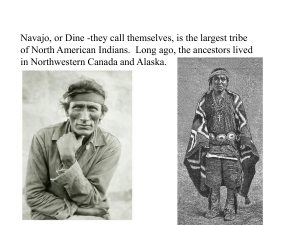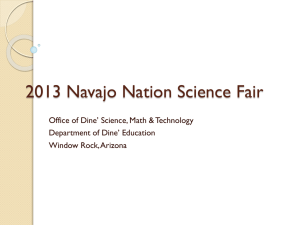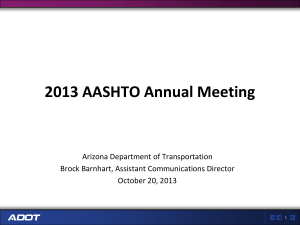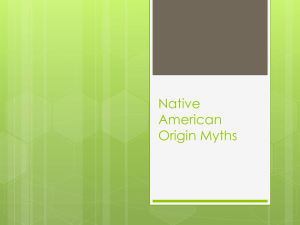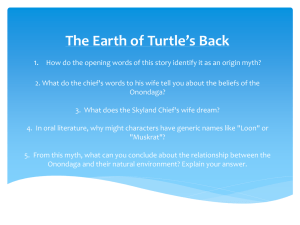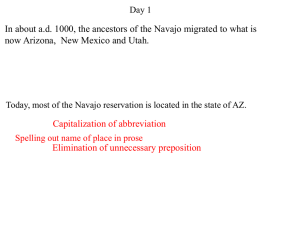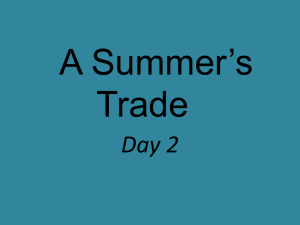pptx - Daniel Hieber
advertisement
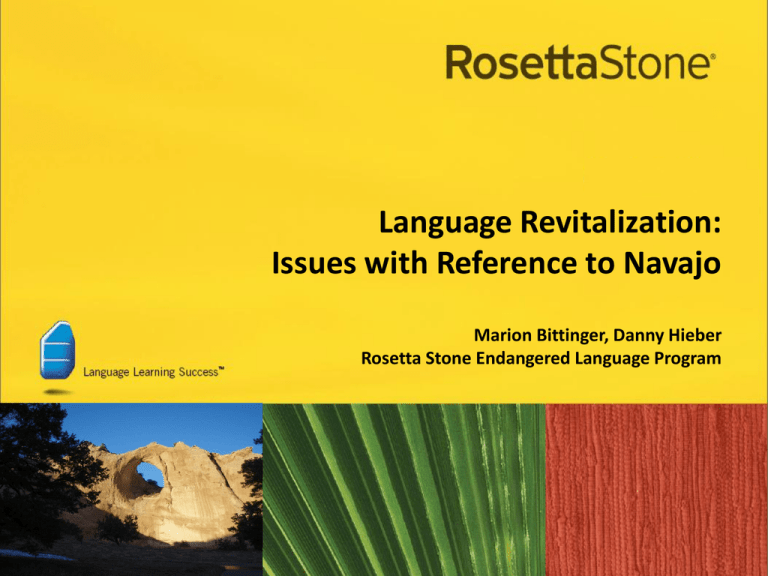
Language Revitalization: Issues with Reference to Navajo Marion Bittinger, Danny Hieber Rosetta Stone Endangered Language Program What is Rosetta Stone®? “My grandma taught me how to talk Navajo, but I’m still learning. She showed me how to cook cake, pizza, eggs with bakend and blue mush. … My grandma taught me how to weave.” Impressions? What worked and why? Difficulties? Hurdles to teaching? The Rosetta Stone Endangered Language Program The Endangered Language Program Mission The Endangered Language Program works with Native language communities to create custom Rosetta Stone software for use in their language revitalization programs. Through a variety of development models designed to make Rosetta Stone software available to a wide range of indigenous groups, we promote global linguistic diversity and embody Rosetta Stone’s belief that language learning makes the world a better place. 6 Endangered Language Program • • • • 1999: 2004: 2006: 2007: • 2007: • 2009: • 2010: • 2011: First project launched Endangered Language Program founded Mohawk Level 1 released Iñupiaq (Coastal) Level 1 and Inuttitut Level 1 released First company grant projects launched Mohawk Level 2 released Chitimacha released Navajo released Iñupiaq (Kobuk / Selawik) released Iñupiaq (North Slope) completed ELP Projects The Navajo Language Navajo is… • The most widely spoken of all North American native languages (est. 150,000+ fluent speakers) • Spoken and taught in 3 or more states • Growing in number of speakers? BUT… 1970 90% of Navajo BIA boarding school children spoke Navajo 1992 18% of Navajo preschoolers knew Navajo 2011 < 5% of Navajo school-aged children were fluent in Navajo Why is Navajo Endangered? Historical: Colonialism • Disease • Missions • War Social: • Language prestige • English dominance in mainstream culture and media Educational: • Boarding school system • Lack of educational support (teacher training, curricula) • No Child Left Behind • English-Only Act of 2000 The Rosetta Stone Endangered Language Program + Navajo Language Renaissance = The Goal: • Use of Navajo Rosetta Stone in 100% of Navajo Nation schools • Navajo Rosetta Stone available in all Navajo Nation Chapter Houses •Use of Navajo Rosetta Stone by Navajo living outside of the Nation Navajo Language Renaissance • • 501 (c)(3) non-profit corporation Composed of Navajo linguists and language educators from Arizona, New Mexico and Utah • Has full support of the Navajo Nation Board of Education • The recipient of a 2007 Rosetta Stone Endangered Language Program grant for software development • All language knowledge is provided by the sponsoring community • All language work takes place within the sponsoring community • All intellectual property, sales, and distribution rights belong to the sponsoring group Navajo is… • An Athabaskan language of the Na-Dené family • An agglutinating, polysynthetic language. A verb can have up to 11 prefixes! • A “verb-heavy” language (many verbs, few nouns) • Tonal – Vowels can be either high or low tone Bikáá’ + dah + ‘a-sdáh-í on up there the thing you sit up on Language Endangerment A Global Phenomenon How many languages are in the world? About 6,900 • By 2100, half these languages will be extinct • One language dies about every two weeks • Half of the world’s languages have fewer than 5,000 speakers • Over 500 languages have fewer than 100 speakers each Living Languages Endangered Languages Choctaw Natchez Tunica Koasati Chitimacha? Languages by Vitality Countries by Number of Languages • Smallest languages 0.2% • 8 million speakers 20.4% • 1,200 million speakers 3,586 • Mid-sized languages 2,935 79.5% • 4,500 million speakers • Biggest languages 83 26 Should We Revitalize? “We have room for but one language in this country, and that is the English language, for we intend to see that the crucible turns our people out as Americans, of American nationality, and not as dwellers in a polyglot boarding house.” ~ Theodore Roosevelt “Nothing is more American than the languages of her first people.” ~ Ryan Wilson (Oglala Lakota) Language Choice “The right to language choice includes the right to choose against a language.” Costs of revitalization: Language revitalization or… • Development • Education • Social services “Endangered languages are always endangered for economic reasons.” “The decision tends to be made by the very youngest speakers, 6- or 7year olds, under duress or social pressure.” Challenges to Revitalization • Political – Tribal – lack of community consensus; tribal politics – Legal – state, federal, and tribal law • Informational vacuum – Level of endangerment – Assessing success in revitalization • Logistical – Travel – remote geography – Technical – elders and technology; digital infrastructure – Surprises – hurricanes, oil spills, drought, snowstorms, whaling festivals, mardi gras Challenges to Revitalization • Cultural – Divergent goals between linguists and communities – Traditional versus evolving views of language • Linguistic – Lack of standardization (vocabulary, orthography) – Complex grammatical structures – Sacred language • Financial – Compensation – experts work mostly pro bono – Funding Language Choice Do language revitalization and other forms of development always have to be mutually exclusive? No! • Development programs combined with a focus on the local language tend to work better • Dropout rates decrease and test scores increase for schools taught in their mother tongue • Language is learned better in its social context • Language and culture are best taught together Holistic and integrated solutions work best Reasons for Revitalization? • • • • • • • • Languages are inherently valuable Languages are valuable for scientific inquiry Languages are valuable as a cultural heritage Languages are valuable as a store of knowledge (relates to Sapir-Whorf) Languages are valuable for the social functions they fulfill Languages are valuable for economic purposes Languages are valuable because people value them Languages are a necessary marker of identity Special thanks to: Our many Navajo friends and colleagues For more information: Marion Bittinger Manager, Rosetta Stone Endangered Language Program (540) 236-5331 mbittinger@rosettastone.com Danny Hieber Content Editor, Rosetta Stone Endangered Language Program (540) 236-7580 dhieber@rosettastone.com Slide 12: Sources – 1970 statistic: U.S. Department of the Interior. Bureau of Indian Affairs. Navajo Language Maintenance II: Six-Year-Olds in 1970, by Bernard Spolsky. Washington, D.C., August 1971. – 1992 statistic: Platero, Paul R. Navajo Head Start Language Study. In The Green Book of Language Revitalization in Practice, Leanne Hinton and Ken Hale (eds.), Academic Press, pp. 87-97. 2001. – 2011 statistic: anecdotal Slide 20: – Extinct by 2100: Krauss, Michael. The world’s languages in crisis. Language, Vol. 68, No. 1, pp. 4-42. 1992. – Every two weeks: Crystal, David. Language Death. Cambridge University Press, p. 19. 2001. – Language numbers: Lewis, M. Paul, ed. Ethnologue: Languages of the World, 16th edition. SIL International. 2009. Slide 21: Ethnologue.com Slides 22-24: UNESCO Atlas of the World’s Languages in Danger – http://www.unesco.org/new/en/unesco/themes/languages-and-multilingualism/endangeredlanguages/ Slide 25: Worldmapper.com – http://www.worldmapper.org/display_languages.php?selected=583# Slide 26: Languages by size – Harrison, K. David. When Languages Die: The Extinction of the World’s Languages and the Erosion of Human Knowledge. Oxford University Press, p. 14. 2007. Slide 28: – Right to choose: Hinton, Leanne. Commentary: Internal and External Advocacy. Journal of Linguistic Anthropology, Vol. 12, No. 2, pp. 150-156. 2002. – Economic reasons: Ladefoged, Peter. The disappearing sounds of the world’s languages. CD-ROM. HRELP, 2004. – Youngest speakers: Harrison, K. David. Ibid.
